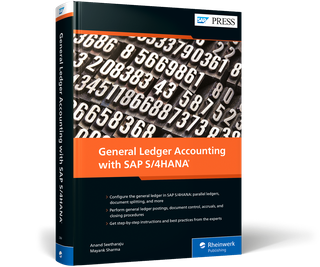By Anand Seetharaju and Mayank Sharma
We explain accounting and SAP General Ledger with instructions on customizing. We share practical experiences, organized into nineteen chapters:
Table of Contents
- Chapter 1 Introduction
- Chapter 2 Organizational Structure
- Chapter 3 Integrated Business Processes
- Chapter 4 Fiscal Year and Posting Periods
- Chapter 5 Parallel Reporting
- Chapter 6 Currencies
- Chapter 7 Master Data
- Chapter 8 Documents and Posting Control
- Chapter 9 Document Splitting
- Chapter 10 Profit Center Accounting
- Chapter 11 Document Posting
- Chapter 12 Document Clearing
- Chapter 13 Cost of Sales Accounting
- Chapter 14 Financial Close
- Chapter 15 Accruals Management
- Chapter 16 Reporting and Analytics
- Chapter 17 Conversion to the General Ledger in SAP S/4HANA
- Chapter 18 General Ledger with Central Finance
- Chapter 19 Miscellaneous Topics
- Continue Reading
Chapter 1 Introduction
We introduce financial accounting and provide knowledge about working with general ledgers. Then, we transition into SAP S/4HANA, explaining general concepts and the Universal Journal.
Chapter 2 Organizational Structure
This chapter covers topics on organizational structure for the General Ledger.
Chapter 3 Integrated Business Processes
You learn how cross-component integration is essential for a fully functional finance system. In this chapter, we walk you through several cross-functional process flows and their relevant journal entries in the T-account format.
Chapter 4 Fiscal Year and Posting Periods
We provide insights on designing fiscal year and calendar requirements and cover step-by-step instructions on configuring fiscal year and posting period variants.
Chapter 5 Parallel Reporting
You'll learn the basics of parallel accounting with the SAP S/4HANA general ledger. All large corporations require some form of parallel accounting to meet accounting standards, such as Generally Accepted Accounting Principles (GAAP) or International Financial Reporting Standards (IFRS), and often a local GAAP. This chapter provides a solid foundation on parallel accounting concepts in the SAP S/4HANA General Ledger.
Chapter 6 Currencies
We provide extensive coverage of currencies in the SAP S/4HANA general ledger, describing the exchange rate application and other relevant configurations. The final section covers implementing a new currency on a live system.
Designing an effective chart of accounts is essential for any successful financial accounting system. In addition, a well-designed and implemented chart of accounts can give your organization's management better control and governance and the ability to analyze financial data quickly.
Chapter 7 Master Data
We provide key points you should remember when designing a chart of accounts in general ledger accounting. Later, this chapter provides step-by-step instructions on creating account master data in general ledger accounting. Documents and journals are used interchangeably in general ledger accounting.
Chapter 8 Documents and Posting Control
We walk you through the document principle and the document controls functionality when posting documents in general ledger accounting and several important customizing activities. Segment reporting in financial accounting is one of the many GAAP disclosure requirements. Enabling document splitting in general ledger accounting can accomplish this.
Chapter 9 Document Splitting
We comprehensively overview the General Ledger, customizing, and segment reporting. This chapter shows you how to introduce document splitting on a live system.
Chapter 10 Profit Center Accounting
SAP has integrated profit center organizational data with the Universal Journal. As a result, you'll need basic knowledge and an understanding of profit center accounting in the SAP S/4HANA general ledger. Chapter 10 focuses on profit center concepts, including planning, actual postings, and transfer postings. Finally, we provide insights on profit center reorganization and key considerations when planning changes.
Chapter 11 Document Posting
We explain document posting in general ledger accounting in SAP S/4HANA. This chapter walks you through parking and holding documents, along with the workflow in general ledger accounting. This chapter further expands on how you can post recurring journal entries. We also outline how to enhance document posting processes with substitution and validation rules in general ledger accounting.
Chapter 12 Document Clearing
Document clearing ensures a business transaction is complete in SAP financial accounting. However, finance implementation consultants and accountants must consider several nuances when clearing documents.
Chapter 12 imparts this knowledge so clearing-related activities are performed efficiently to speed up period-end closing activities.
Chapter 13 Cost of Sales Accounting
We provide a solid introduction to the cost-of-sales concept. During document posting in the Universal Journal, we dive into functional areas and their derivation. You'll also learn about customizing activities related to cost-of-sales accounting.
Chapter 14 Financial Close
Understanding period-end closing tasks is critical for closing your books on time. With real-time closing requirements in mind, this chapter focuses on period-end closing activities, covering manual and automated processes. We provide insights into several closing tools offered by SAP, such as the SAP S/4HANA Financial Closing Cockpit, SAP S/4HANA Cloud for advanced financial closing, and intercompany matching and reconciliation (ICMR).
Chapter 15 Accruals Management
Accruals and deferrals are essential for matching revenues against expenses. Chapter 15 explains accounting concepts for accruals and deferrals with some general examples. Then, we discuss the SAP accrual engine and cover different accruals. This chapter concludes with migrating manual accruals to the SAP S/4HANA accrual engine.
Chapter 16 Reporting and Analytics
You'll learn all about the general ledger reports and analytical tools available in SAP S/4HANA, starting with the basics of reporting. Then, we dive deeply into financial system versions (FSVs) and their creation, including managing global hierarchies or creating financial statement versions. Then, we cover SAP Fiori apps that are available for general ledger accounting. We conclude this chapter by highlighting other reporting tools, such as advanced compliance reporting (ACR) and group reporting.
Chapter 17 Conversion to the General Ledger in SAP S/4HANA
Customers migrating from the classic general ledger to general ledger accounting in SAP S/4HANA will need to understand the challenges and steps involved in system conversion. Chapter 17 provides an overview of the SAP S/4HANA general ledger conversion process, highlighting the necessary SAP Notes for further guidance.
Chapter 18 General Ledger with Central Finance
Customers implementing SAP Central Finance face different challenges from a General Ledger point of view. Chapter 18 covers the challenges, mapping rules, and configuration tasks for implementing SAP Central Finance.
Chapter 19 Miscellaneous Topics
We cover topics otherwise not covered in this book that we still feel are essential to implementing the General Ledger in SAP S/4HANA. We walk you through several issues, such as scheduling jobs, using TVARVC tables, document archiving, and authorizations.



